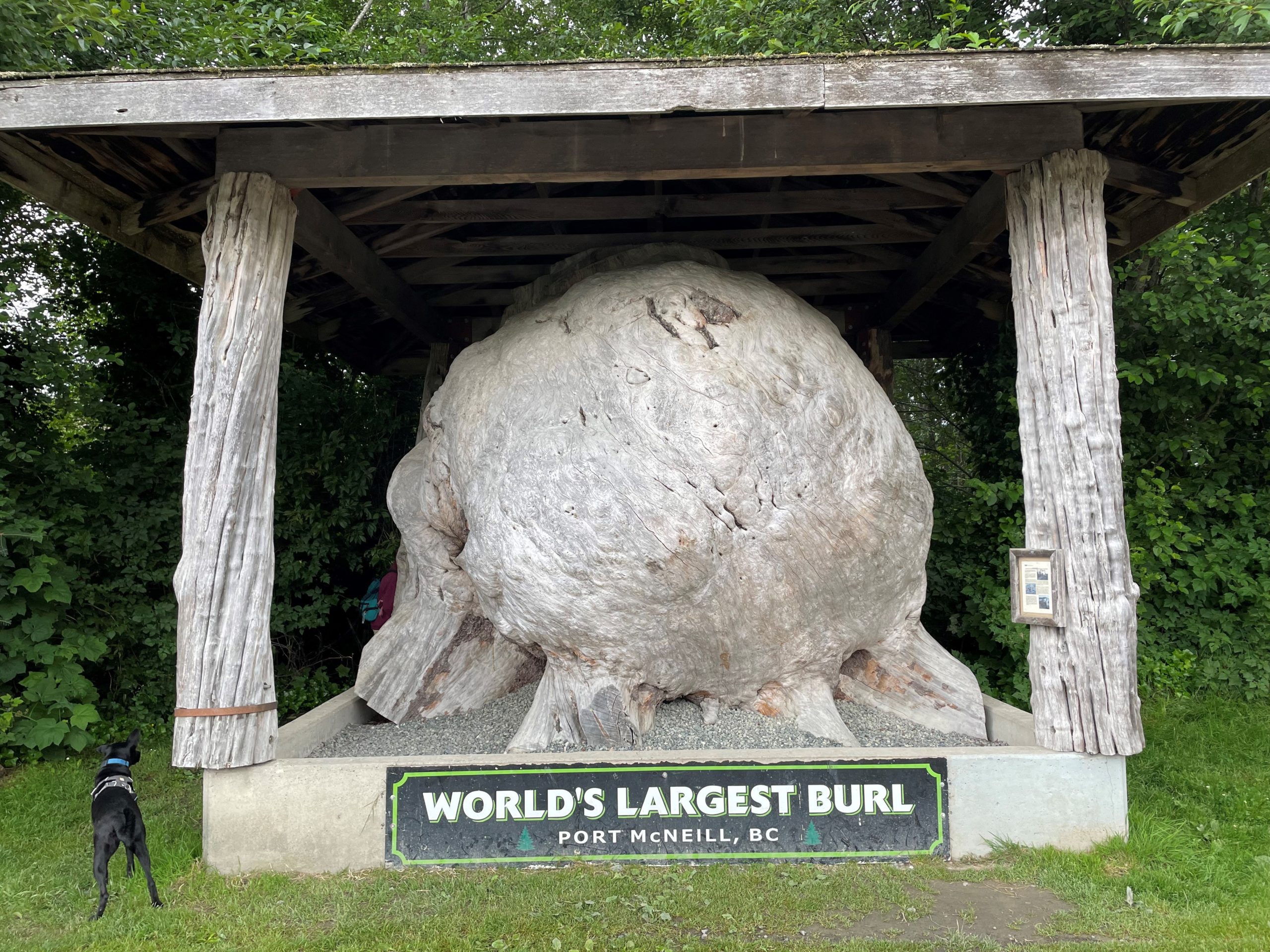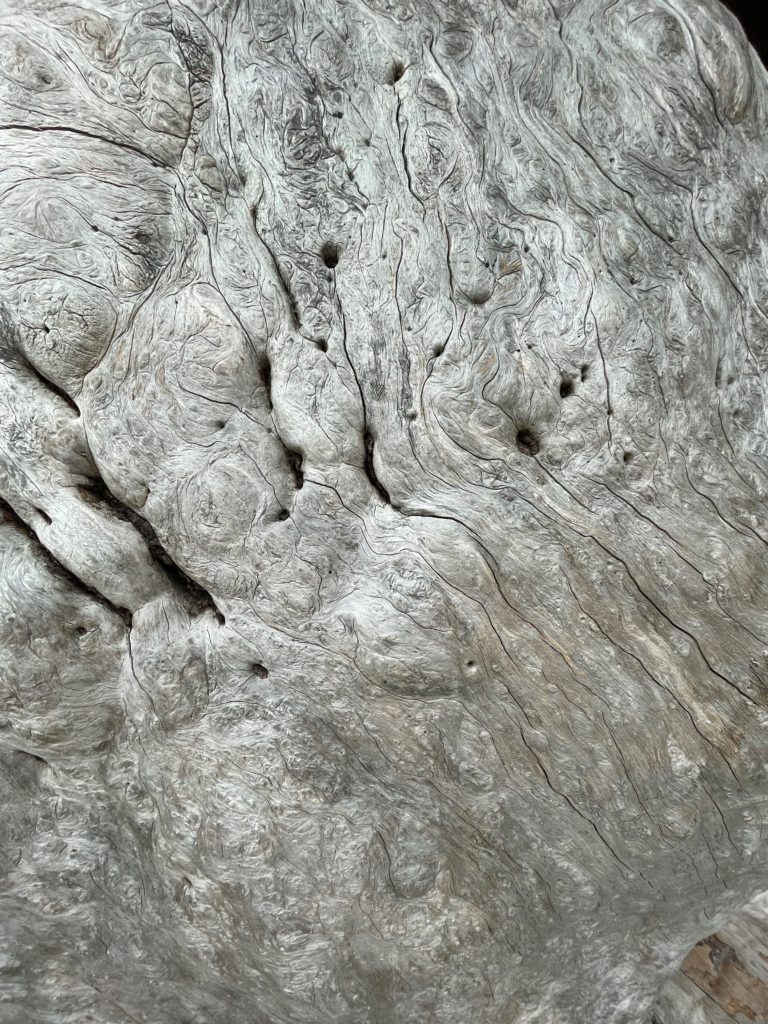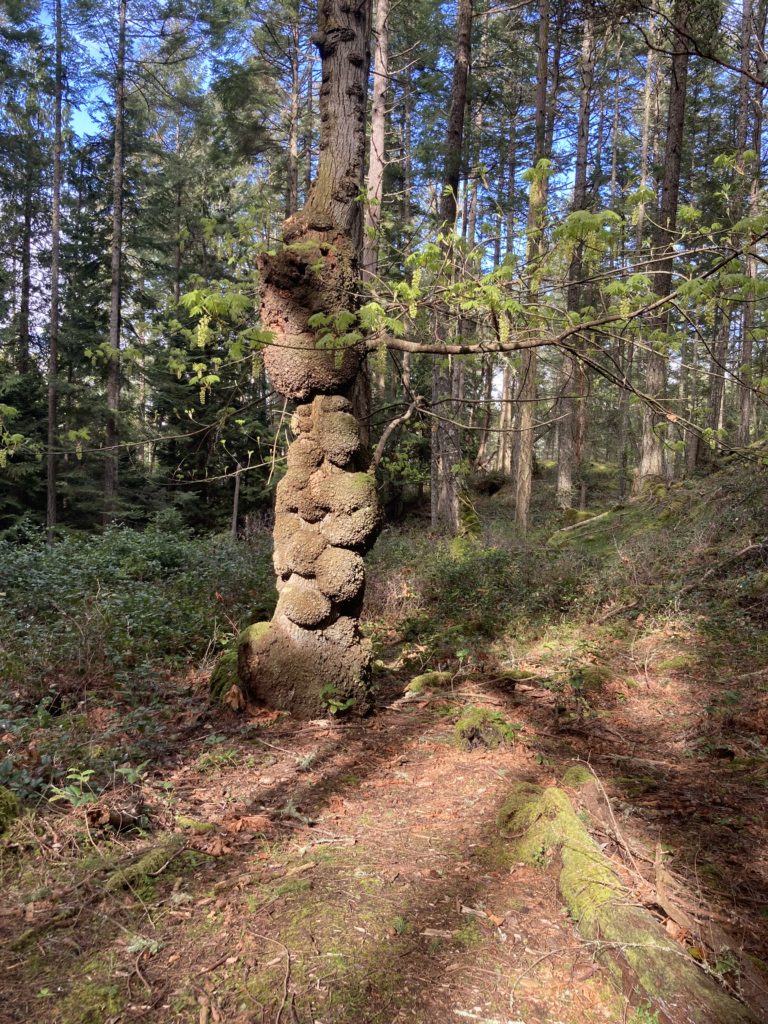The Burl
Who knew? Port McNeill, British Columbia, is home to the World’s Largest Burl.

The “Ronning Burl” originated from a 525-year-old Sitka Spruce tree and weighs more than 20 tons.
Reading the information posted next to the burl, I learned that burls are both bad and good. They’re bad because they can weaken trees and make them susceptible to harmful diseases and wind damage. Burl wood has poor structural qualities for lumber. Also bad.
But burls are highly sought after by furniture woodworkers. Burl wood possesses tremendous natural beauty. Bark inclusions, pitch pockets, and diverse growth ring patterns create rich diversity in burl wood color, patterns, and irregularities, which is prized for decorative furniture such as coffee tables, wall clocks, and bowls. All good.
Like so many other things burls are either bad or good, depending on your perspective.
Reading Kessler, I learned that people who experience traumatic grief – grief triggered by a sudden loss – often have a hard time focusing on anything other than the trauma, the bad stuff. He tells of one case where a woman whose son had died unexpectedly could not get the image of her son in the morgue out of her mind. Kessler coached her to try to introduce a happy memory of her son – something good – whenever the horrible image came up. With practice, the happy memory takes hold and the hurtful image recedes. Over time, the good wins out over the bad.

Similarly, ever since I held Jocelyn as life left her, I have been haunted by the images burned into my brain during those final moments. They invade both my waking and sleeping hours, coming unbidden at seemingly random intervals.
My therapist explained to me that the brain is like a big filing cabinet. Each of your thoughts, images, and experiences gets put in an assigned file. But your brain has no file for a sudden traumatic experience. It goes haywire trying to figure out what to do with it.
Remembering the Kessler passage, I tried to think of a happy memory to supplant the traumatic images. What instantly popped into my mind might seem innocuous but held special meaning for me.
The day before she died, we had cast off from our slip at Canoe Cove and sailed ten nautical miles to Stuart Island, the northwestern-most island in the San Juan group. Our plan was to stay one night at the island, then cross to Port Townsend the next day.
Arriving at the island’s harbor, we found we were all alone. Normally a popular spot, there were no other boaters. It was April, just a bit early in the season for most folks.
We dinghied to shore and took a leisurely hike on empty trails through lush, moss-strewn woods to an old one-room schoolhouse that served the handful of families who lived on the island over the past century. A small unattended library was open next to the schoolhouse where we browsed the posters and photos about those people. Jocelyn seemed happy.
Walking back from the schoolhouse, we occasioned past a tree that had an interesting feature – a burl. We paused to inspect it.
Returning to the Windleblo, we made dinner and read some before retiring.

Perhaps this memory jumped to the front of the line when I reflected on Kessler’s advice only because it was the most recent. But I think there was more to it. It stood out because to me it represents the best of our life together. Enjoyment of nature. Quality time together. Plus, I got to have Jocelyn all to myself. None of the distractions or demands of life at home. Just the two of us away from it all.
Of course, when I look back there are many memories to cherish.
Someone once told me that people will not remember the words you say to them; rather, they will remember the way you made them feel. Each of my memories of Jocelyn is colored by this notion.
Regardless of occasion or event, she had a manner that put you at ease. She listened. She empathized. With her, you couldn’t help but feel that she cared about you, that you were special to her. And her deeds proved the feeling was justified. She always put down whatever she was doing to help anyone who needed her.
Maybe I had a soft spot for her. Well, okay, I absolutely had a soft spot for her. I loved her more than anything.
But it wasn’t just me. You heard it over and over at her Ceremony of Gratitude. She had that effect on everyone.
Though I can catalogue the special occasions – the birthdays, holidays, vacations, trips, and so forth – for me the most special memories are the more routine. Little snippets of our life together that come to mind when I think of her.

Sharing morning coffee as she solved a crossword puzzle. The kiss goodbye as I left for the office for the day. Sharing an evening meal after a long day at work. The click of her keypad as she entered numbers when she worked. The click of her knitting needles as we watched TV together on the loveseat recliner after dinner, sometimes playing footsie. Yardwork and gardening together on the weekends. Admiring baby clothes and blankets she had sewn to have ready as gifts just in case. And more.
Ironically, I cherish the time we spent together in isolation during that first long COVID winter. I would jokingly refer to it as our period of 254 consecutive “date nights.” Like on the Windleblo, I didn’t have to share her with anyone.
Listed just before the item on developing a new self-identity in my grief therapist’s “Reconciliation Tasks” handout is Item #3: “Remember the person who’s gone.” Through memories, I can keep Jocelyn in my heart. The grief can morph into love.
Like a burl, what you see depends on your perspective. Trying to keep happy memories – the good stuff – front of mind can ward off pain and keep the bad stuff away.

Nice burls Jack. As you mentioned, the wild grain is highly sought after by woodworkers experienced in veneer work.
Training the mind is a skill practiced by meditators of all followings. We forget sometimes that the mind is a muscle that not only needs exercise, but also discipline.
The act of meditating in its simplest form is nothing more than taking the unintended chaos of the mind that invades it all too often, and temporarily stopping it. Then the only question is what thoughts does one want to replace the chaos with. Sounds simple but the mind is constantly drawn back to its uncontrolled state and the meditator is forced to rein back in the control and back to the intended state, or focus.
That’s what you are doing when your mind wants to return to that hurtful incident and you then choose to think happy thoughts. It takes work and effort, but if one is diligent than they are eventually rewarded with the desired redirect becoming automatic.
Good luck buddy. Let’s get together on your return.